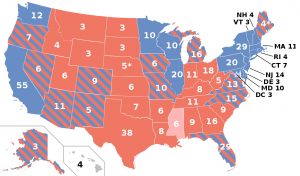As I have written in this series, the field of competitive strategy seeks to understand why some firms continuously out-perform their rivals in terms of sustainable competitive advantage and superior financial performance. Why does Amazon continue to amaze nearly everyone in terms of continual superior performance and increases in its stock price? And recall Amazon almost went bankrupt early in its history. The answer lies in large part on a clear conception of competitive strategy. The clear conception also unfolds as a story that evolves and changes as the competitive landscape changes. But this is key: the unfolding story needs to be aligned and consistent with the clear conception. Stories that flip-flop with no unifying theme usually leads to bad performance over time. Proper alignment of the unfolding story to the clear conception in turn allows a keen focus on operations excellence, which keeps the organization grounded in initiatives that are doable and that allow the firm to win.
The Low Cost/Low Price Amazon Initiative
Think again of Amazon. From its inception it has been a clear Low Cost/Low Price Provider, initially to be the world’s largest bookseller. But it quickly unfolded a story with a flurry of continuing new initiatives consistent with its very clear conception being a Low Cost/Low Price Provider: ZShops, acquisitions, drones, micro-distribution centers to allow same day delivery, and delivery on Sunday are just a few examples of its unfolding story. We can envision how Jeff Bezos excursions into space commerce can fit. But I have to assume the acquisition of the Washington Post newspaper also fits. We shall see.

I have found over the last thirty-five years that sometimes the basics of competitive strategy can be forgotten as the crush of business demands focus on fighting fires. If the firm is not careful, this day-to-day firefighting can cause a previous clear competitive strategy to splinter and cause chaos in the firm. The purpose of this article is to discuss the few keystones for firms formulating their competitive strategies. We will review two key tenants that have served well over the years but also discuss how these are changing in today’s business world.
Two Key Tenents of Competitive Strategy
Without a doubt the most important decision in formulating a competitive strategy is to decide whether the firm will be a Low Cost/low Price Provider or a Differentiator. Amazon and Wal-Mart continue to write the book on the low cost/low price positioning option. Rolex, Neiman Marcus, and Lamborghini are examples of many of the pure differentiator positioning option.
It is relatively easy to decide on paper which competitive strategy option your firm should pursue. What is so difficult is changing from one to another and over time making key new decisions that are consistent with the chosen positioning. With the speed of today’s business world, there are forces everywhere that can drive the firm to become out of alignment with its chosen strategic positioning or prior “clear conception”. Firms can chase pockets of new growth via acquisitions and organic growth that can lead to a portfolio of products and businesses that are a mixture – some are Low Cost/Low Price Providers and others are Differentiators. This is usually deadly for a firm as balancing the demands of different competitive strategies is very difficult. General Electric is a great but rare example of a firm who can manage a diverse portfolio of businesses with different strategic positioning options. But this is not the norm.
Choosing to be a Low Cost/Low Price Provider or a Differentiator is huge. Each form of strategic positioning brings with it myriad choices in operations that must be consistent with the positioning. For instance, the Low Cost/Low Price option always demands the firm strive for high market share through low pricing and high volume, and high degrees of automation to keep labor costs as low as possible. It also demands a hiring process that can identify and hire a large amount of trainable people. Processes and procedures must reinforce standardization across the business. If the firm does not do these minimal things, it usually finds that costs will rise to unacceptable levels. The Differentiator option demands hiring great people who are independent and prone to creativity and innovation. Independent high performers are allowed the freedom to act in terms of what is in the best interest of the firm, thus rules and procedures are kept to a minimum. Standardization is usually an enemy of innovation. New product development is crucial. These operations decisions allow the successful differentiator to continue to offer products and services that customers gladly pay premium prices for.
Indecision Leads to Declining Revenue
Many firms, however, become “stuck in the middle”. This means they have not made a clear choice to become and be a Low cost/Low Price Provider or a Differentiator. In these “stuck in the middle firms”, costs are too high to be a low cost/low price provider and their innovation efforts are lackluster, leading to products for which premium prices will not be paid. Higher costs and lower prices relative to rivals who have made a clear choice over time almost always leads to headaches or outright financial disaster. Follow any firm whose stock price has been trending down over the last five-year period. The culprit is usually being “stuck in the middle”. As an example, this is my view of why the Fossil Group has experienced declines in its stock price over the last five years. This firm makes watches and fashion accessories and my analysis is based only on a review of publicly available documents, as Fossil is a publicly traded firm. I invite the reader to review their annual reports, and 10K and 10Q documents for their opinions. They have chased pockets of expected growth via acquisitions and have ended up with a portfolio of diverse competitive positions. As I stated above, this complexity is very difficult to manage and lead for competitive advantage.

For forty years strategists have stated a firm must choose to have one and only one competitive strategy option. But in today’s business world firms are finding they can try to move to a “dual advantage”. This is developing low cost and differentiation capabilities at the same time. Until recently, Apple has enjoyed a dual advantage as its firm valuation has demonstrated. Apple has outsourced and off-shored production and assembly to drastically lower costs. This has allowed Apple to focus on its key and unique competencies that drive superior customer value and higher prices. Technology investments allow sleek, fast supply chains and people productivity gains. Investments in software to understand the changing “voice of the customer” and data analytics allow firms to continually see new customer opportunities to develop products and services for which premium prices are gladly paid. And firms are forging global portfolios of partnering firms allowing them to eliminate certain capital investments altogether. Readers astute in finance will recognize these actions increase the financial valuation of the firm over rivals who are slower to put these actions into play.

I trust the reader will agree with me that a clear competitive strategy is vital for firms. At this writing, though, an interesting thing is happening with the election of Donald Trump to the US presidency. Actually, what has seemed so soothing to many voters to return jobs to the United States will actually reverse some of these drivers of increases in firm valuation. Returning manufacturing and jobs to the high-cost United States, while sounding good, will likely increase the cost position of many US firms. However, President Trump is also promising much lower corporate taxes as an incentive to keep manufacturing in the US or have it return from offshore. It is beyond the scope of this article to discuss these dynamics in detail. I only mention it as we are set for a new round of changing views about what a sound competitive strategy is. The “clear conception” mentioned above is the relatively easy part. The “unfolding story” is where the excitement is.
Are your top management team and board of directors up to the challenge?
This article is part of a series on what causes a firm’s value to increase
Dr. William Bigler is the founder and CEO of Bill Bigler Associates, He is and professor of strategy and the former MBA Program Director at Louisiana State University at Shreveport. He was the President of the Board of Strategic Planning in 2012 and served on the Board of Directors for Nitro Security Inc. from 2003-2005. He has worked in the strategy departments of PricewaterhouseCoopers, the Hay Group, Ernst & Young and the Thomas Group. He can be reached at bill@billbigler.com or www.billbigler.com.
